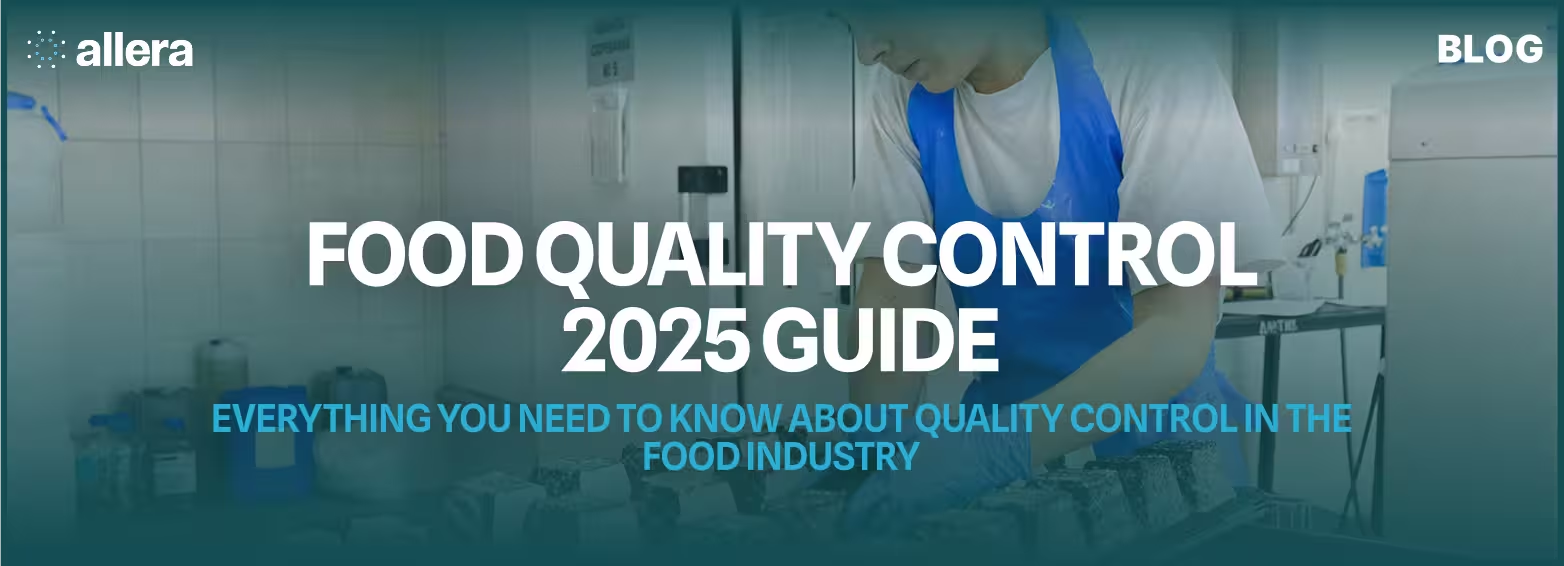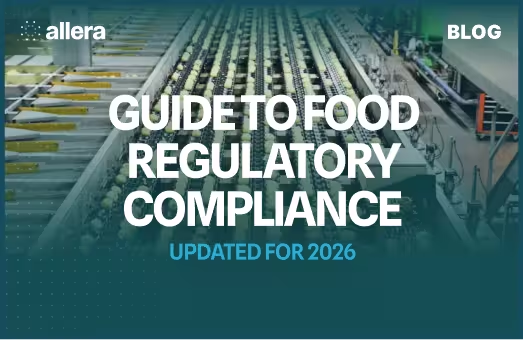

Food Quality Control: 2025 Guide for Food Manufacturing

Key Takeaways
- Focus on preventing hazards, not just reacting to them.
- Follow FDA FSMA guidelines to strengthen food quality practices.
- Adopt HACCP principles to systematically analyze and manage risks.
- Document processes for consistency, inspections, and regulatory compliance.
- Regularly review and adjust your quality controls for continuous improvement.
Why food quality control matters in manufacturing
Food safety is never a guessing game. About 48 million people in the U.S. get sick from foodborne illnesses each year, leading to hospitalizations, product recalls, and lost consumer trust. As a quality control professional, you know that a single contamination event can disrupt operations, tarnish your brand, and put public health at risk. By building strong food quality control programs, you protect both your customers and your company.
At its core, food quality control means setting and enforcing standards that keep products safe and consistent from farm to table. The Food Safety Modernization Act (FSMA) emphasizes prevention, encouraging facilities to anticipate threats of contamination in everything from raw materials to transportation. Rather than waiting for problems, you build checkpoints and safeguards to stop risks before they reach the public.
If you're more interested in quality assurance, check out our blog on quality assurance in the food industry: 5 changes in 2026.
FSMA requirements: Taking a prevention-first approach
FSMA 204 has reshaped food manufacturing by urging proactive safety planning. Its most impactful rules include:
- Preventive Controls for Human Food: Requires facilities to establish written food safety plans, identify hazards, and document corrective actions and verification steps at critical points of production.
- Produce Safety Rule: Establishes minimum standards for growing, harvesting, and handling produce to reduce microbial contamination.
- Sanitary Transportation Rule: Requires clean transportation practices, temperature controls, and training for personnel handling perishable goods.
- Food Traceability Rule: Enforces detailed ingredient and product tracking across the supply chain.
According to the FDA, these measures aim to significantly reduce preventable illness rates while creating more accountability in food manufacturing.
Putting FSMA into practice: Building a blueprint
Start with a risk assessment across your entire supply chain. Map sourcing, production, and distribution, then pinpoint where risks—like cross-contamination or temperature abuse—are most likely to occur. For example, a broken refrigeration unit during transport can allow rapid bacterial growth. Instead of waiting until consumers complain, FSMA calls for logs and checks that flag deviations in real time so you can intervene immediately.
Using HACCP to strengthen food quality control
Hazard Analysis and Critical Control Points (HACCP) is one of the strongest tools for building a food safety system. It provides a logical framework to identify, evaluate, and control hazards. Since the FDA introduced its first HACCP rule in 1995, these HACCP principles have become the backbone of hazard prevention in U.S. food manufacturing.
Identifying hazards and critical control points
List all possible contamination points: unreliable raw material suppliers, untrained staff, or production line choke points. Once hazards are mapped, determine which pose significant risks. These risks become your focus areas. Critical control points (CCPs)—such as pasteurization—require constant monitoring because failures there can directly result in unsafe products.
Setting limits and corrective actions
Each CCP must have measurable limits, such as minimum pasteurization temperatures or pH ranges. If limits are exceeded, corrective actions like reprocessing or discarding batches are required. Documenting each step ensures consistency and verifiability.
To simplify HACCP recordkeeping, Allera’s Document Control Software for food manufacturers centralizes plans, logs, and approvals, ensuring audit-ready accuracy.
Environmental monitoring programs: Detecting invisible threats
Environmental monitoring means more than surface cleaning. It requires systematic testing of facility zones, food contact surfaces, and equipment to uncover pathogens and allergens before they spread.
High-risk zones to monitor in your facility
- High-Risk Production Areas: Open production lines or raw ingredient processing zones.
- Packaging Areas: Sealing and labeling stations where contamination can compromise finished goods.
- Storage and Shipping Areas: Long-term holding zones where pathogens can persist unnoticed.
Routine swabbing and microbial testing across these zones helps identify root causes, whether from floor cracks, poorly maintained drains, or improper handwashing practices.
Validating cleaning and sanitation procedures
To prove sanitation effectiveness, test surfaces both before and after cleaning. If microorganisms repeatedly appear, evaluate cleaning agents or methods. Continuous improvement here strengthens both consumer safety and brand reputation.
Recordkeeping and compliance: How documentation supports audits
According to the FDA, over 53,000 U.S. food facilities fall under FSMA oversight, all of which must keep complete, accessible records. These records demonstrate hazard controls, preventive actions, and corrective measures.
Maintaining consistent logs
Track refrigeration checks, allergen control cycles, pest control, and sanitation logs. Consistency makes it easier to identify inefficiencies. For example, repeated equipment temperature deviations may signal the need for maintenance or retraining.
Internal audits for audit-ready documentation
Internal audits should validate that written procedures match real-world practices. Discrepancies—such as skipped sanitation steps—can be corrected before regulators intervene.
With Allera’s audit-ready document control tools, manufacturers receive version control, alerts, and audit trails that ensure compliance confidence.
Training employees for better food quality control
Technology alone doesn’t guarantee food safety. Employees who understand the “why” behind procedures act as the first line of defense.
Engaging staff with practical examples
Show how oversight can trigger costly recalls or hospitalizations. Hands-on demos—like thermometer calibration or correct sanitizing—cement the importance of quality practices.
Staying current with new regulations
Food safety oversight evolves rapidly. For instance, FDA’s food safety budget in 1997 was $203 million (23.5% of its total) and has grown significantly since then to match rising regulatory demands. Staying updated on FSMA amendments and innovations in pathogen detection ensures your facility remains compliant.
FSMA requirements for food quality control
Food Traceability, a core FSMA requirement, enables facilities to pinpoint contaminated batches and recall them quickly without over-withdrawing safe products.
Labeling and digital batch records
Digital systems and barcoding can automate traceability, linking raw materials to finished goods. If contamination arises, affected products can be quickly identified and quarantined.
Ensuring supplier transparency
Your traceability is only as good as your supplier data. Encourage suppliers to adopt modern recordkeeping practices and digital reporting.
See how Epicurean Butter improved supplier transparency with Allera, streamlining supplier document collection and compliance workflows.
Partnering with regulators: Leveraging FDA, FSIS, and CDC resources
The FDA oversees most food products, FSIS monitors meat and poultry, and the CDC tracks outbreaks and provides prevention resources. Building collaborative, transparent relationships with agencies ensures quicker access to guidance and training opportunities.
Learning from inspection feedback
Treat inspection results as constructive insights. Correct deficiencies immediately and document improvements to build regulator trust.
Using published guidance and resources
The FDA FSMA portal provides detailed compliance guides, while the CDC’s food safety hub shares best practices against Salmonella, E. coli, and other pathogens. These free resources help facilities stay aligned with evolving standards.
Quality Control Crisis management: Preparing for recalls and emergencies
Even robust systems can face crises. A clear crisis plan allows for swift, transparent communication.
Recall preparedness and execution
Have systems in place to track and isolate affected batches quickly. Communicate recalls factually and calmly to protect consumer trust.
Corrective actions to rebuild confidence
Post-crisis, review your HACCP or FSMA plans for weaknesses and document corrective actions—whether equipment upgrades or new training initiatives.
Innovating food quality control: Tools for 2025 and beyond
Emerging technologies continue to reshape quality control. Examples include:
- Automated IoT sensors for monitoring temperature and moisture
- Real-time microbial detection technology
- Digital audit trails and compliance alerts
- Predictive analytics to detect recurring compliance issues
Facilities that adopt these innovations remain competitive and responsive to both regulatory and consumer expectations.
Conclusion: Staying audit-ready with Allera Technologies
Food quality control is a layered strategy built on FSMA, HACCP, robust documentation, and continuous training. By strengthening these areas, you protect your products and your brand.
When you’re ready to simplify documentation and supplier management, Allera Technologies’ compliance software solutions help food manufacturers stay audit-ready. With the right tools, you can reduce risk, streamline processes, and maintain the highest quality standards in 2025.




.avif)
.avif)

.avif)

.avif)


.avif)